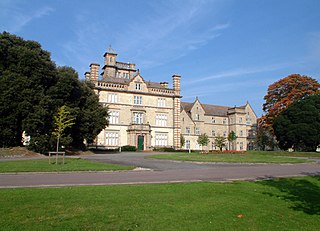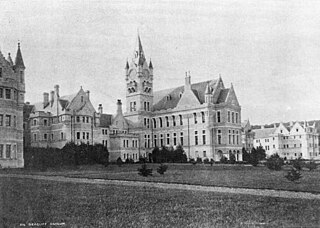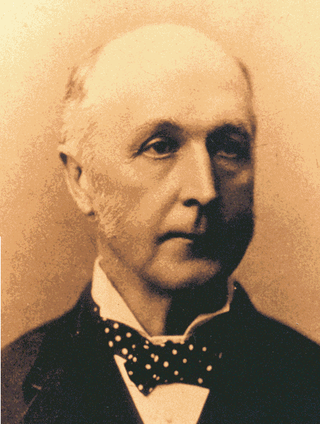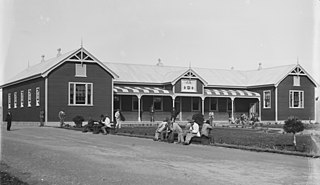Unitec Institute of Technology is the largest institute of technology in Auckland, New Zealand. 16,844 students study programmes from certificate to postgraduate degree level across a range of subjects.

Austin State Hospital (ASH), formerly known until 1925 as the Texas State Lunatic Asylum, is a 299-bed psychiatric hospital located in Austin, Texas. It is the oldest psychiatric facility in the state of Texas, and the oldest continuously operating west of the Mississippi River. It is operated by the Texas Health and Human Services Commission.
Aradale Mental Hospital was an Australian psychiatric hospital, located in Ararat, a rural city in south-west Victoria, Australia. Originally known as Ararat Lunatic Asylum, Aradale and its two sister asylums at Kew and Beechworth were commissioned to accommodate the growing number of 'lunatics' in the colony of Victoria. Construction began in 1864, and the guardhouses are listed as being built in 1866 though the list of patients extends as far back as the year before (1865). It was closed as an asylum in 1998 and in 2001 became a campus of the Melbourne Polytechnic administered Melbourne Polytechnic's Ararat Training Centre.

Fulbourn Hospital is a mental health facility located between the Cambridgeshire village of Fulbourn and the Cambridge city boundary at Cherry Hinton, about 5 miles (8 km) south-east of the city centre. It is managed by the Cambridgeshire and Peterborough NHS Foundation Trust. The Ida Darwin Hospital site is situated behind Fulbourn Hospital. It is run and managed by the same trust, with both hospitals sharing the same facilities and staff pool.

The Cherokee Mental Health Institute is a state-run psychiatric facility in Cherokee, Iowa. It opened in 1902 and is under the authority of the Iowa Department of Human Services.

Seacliff Lunatic Asylum was a psychiatric hospital in Seacliff, New Zealand. When built in the late 19th century, it was the largest building in the country, noted for its scale and extravagant architecture. It became infamous for construction faults resulting in partial collapse, as well as a 1942 fire which destroyed a wooden outbuilding, claiming 37 lives, because the victims were trapped in a locked ward.

Norristown State Hospital, originally known as the State Lunatic Hospital at Norristown, is an active state-funded psychiatric hospital located outside the city of Philadelphia in suburban Norristown, Pennsylvania. It was originally designed between 1878 and 1880, by the local firm of Wilson Brothers & Company; of which, the original structure was set in a red brick Victorian High Gothic motif. It remains active for its originally clinical intention, and currently serving Bucks County, Chester County, Delaware County, Montgomery County and Philadelphia County, providing clinical services in General Psychiatry and Forensic Psychiatry. Additionally, there are various agencies that sublet state hospital buildings for a variety of psychiatric, residential and social services. These agencies currently make up the majority of services that are offered on the grounds of the hospital.

Kew Lunatic Asylum is a decommissioned psychiatric hospital located between Princess Street and Yarra Boulevard in Kew, a suburb of Melbourne, Australia. Operational from 1871 to 1988, Kew was one of the largest asylums ever built in Australia. Later known as Willsmere, the complex of buildings were constructed between 1864 and 1872 to the design of architects G.W. Vivian and Frederick Kawerau of the Victorian Public Works Office to house the growing number of "lunatics", "inebriates", and "idiots" in the Colony of Victoria.

Frederick Norton Manning, was a medical practitioner, military surgeon, Inspector General of the Insane for the Colony of New South Wales, and was an Australian Lunatic Asylum Superintendent. He was a leading figure in the establishment of a number of lunatic asylums in the colonies of New South Wales and Victoria, and participated in inquests and reviews of asylums throughout the colonies.

Thomas Embling was a medical doctor from the United Kingdom who took an interest in the humane treatment of inmates in asylums before emigrating to Melbourne, Australia where he set about reforming the Yarra Bend Asylum. Later on Thomas Embling took up the cause of the gold miners in Eureka and had a successful career in the early parliament of Victoria.

The Park Centre for Mental Health is a heritage-listed psychiatric hospital at 60 Grindle Road, Wacol, City of Brisbane, Queensland, Australia. It is one of the largest psychiatric hospitals in Australia. The hospital provides a range of mental health services, including extended inpatient care, mental health research, education and a high security psychiatric unit. It was designed by Kersey Cannan and built from 1866 to 1923. It is also known as Goodna Hospital for the Insane, Goodna Mental Hospital, Woogaroo Lunatic Asylum, and Wolston Park Hospital Complex. It was added to the Queensland Heritage Register on 21 October 1992.

Central State Hospital, originally known as the Central Lunatic Asylum, is a psychiatric hospital in Petersburg, Virginia, United States. It was the first institution in the country for "colored persons of unsound mind".

St. Brendan's Hospital was a psychiatric facility located in the north Dublin suburb of Grangegorman. It formed part of the mental health services of Dublin North East with its catchment area being North West Dublin. It is now the site of a modern mental health facility known as the "Phoenix Care Centre". Since the official opening of the Richmond Lunatic Asylum in 1815 the Grangegorman site has continuously provided institutional facilities for the reception of the mentally ill until the present day. As such the Phoenix Care Centre represents the continuation of the oldest public psychiatric facility in Ireland.

The Seaview Asylum was a psychiatric hospital located to the north of Hokitika, in the West Coast Region of New Zealand's South Island, adjacent to the former Westland Hospital. Open from 1872 to 2009, Seaview trained psychiatric nurses and was once the town's biggest employer.
Porirua Lunatic Asylum was a psychiatric hospital located in Porirua. Established in 1887, it was at one time the largest hospital in New Zealand. The patients ranged from those with psychotic illnesses, to the senile, or alcoholics.

Swanbourne Hospital is a heritage listed former mental hospital located in Mount Claremont, Western Australia. Built in 1904, it was the largest stand-alone psychiatric hospital in Western Australia for much of the twentieth century until its closure in September 1972. The hospital was originally known as Claremont Hospital for the Insane, Claremont Mental Hospital and Claremont Hospital. Following the closure of Claremont Hospital in 1972, the original 1904 section of the hospital functioned as the Swanbourne Hospital until 1985. The site was vacant from 1986, until renovated and reopened primarily as an aged care residence in 2018.

Roundway Hospital was a psychiatric hospital in the parish of Roundway near Devizes, Wiltshire, England. It was originally called the Wiltshire County Lunatic Asylum and later the Wiltshire County Mental Hospital. It opened in 1851 and closed in 1995.
Glenside Hospital, as it was known from 1967, previously the Public Colonial Lunatic Asylum of South Australia, Parkside Lunatic Asylum and Parkside Mental Hospital, was a complex of buildings used as a psychiatric hospital in Glenside, South Australia.

Bellsdyke Hospital, also known as Stirling District Lunatic Asylum ('SDLA') or Stirling District Asylum, is a former psychiatric hospital at Larbert, Falkirk that was opened in June 1869 and largely closed in 1997. It was an asylum set up by the Stirling District Lunacy Board.

Mental health in New Zealand generally follows the trends of mental health in other OECD countries. New Zealand's 'outdoor life style' and high standard of living are balanced by isolation and a self-reliant culture, which discourages asking for help. Historically, people with mental health problems were institutionalised, whereas now the focus is on care in the wider community. The stigma around poor mental health has been lessened in recent years as a result of this change and public education campaigns. However, New Zealand's minorities and youth continue to be over-represented in the negative mental health statistics.



















